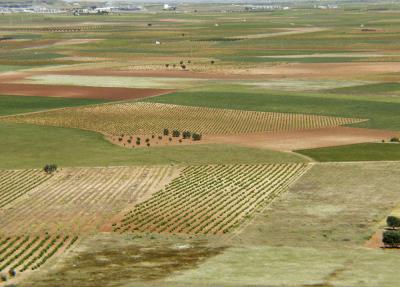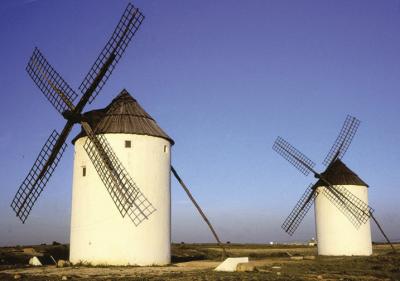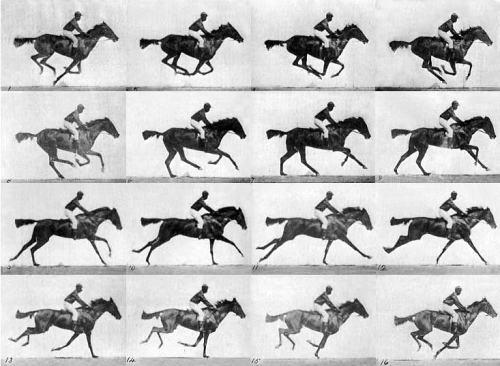Figure 18.1: WWW18 Logo
Music

Flamenco guitars
Animation
The main interest in the logo was Don Quixote and Sancho Panza. After reading the 980 pages of Cervantes book Don Quixote we settled on the well-known story in Chaper 8: Regarding the good fortune of the valorous Don Quixote in the fearful and never imagined adventure of the windmills, along with other events worthy of joyful rememberance. The story is essentially that Don Quixote and his squire Sancho Panza come upon a countryside containing 30 to 40 windmills. Don Quixote says thirty or more enormous giants with whom I intend to do battle. Sancho Panza says What giants?They are windmills; their arms are the sails which turn in the wind. Don Quixote spurred his horse Rocinante crying Flee not, cowards and base creatures for it is a single knight that attacks you. At that point, a gust of wind starts the sails moving as he charged full gallop towards the first windmill. He thrust his lance into the sail; it broke into pieces and Don Quixote and horse were picked up. Meanwhile Sancho Panza hurried to help as fast as his donkey could manage. Don Quixote is convinced that Freston the Wise has turned the giants into windmills to deprive him of a great victory.
This was the basis for the animation. The intention early on was to have both the horse and Don Quixote picked up by the windmill and for Sancho Panza to replace the broken lance by a tree branch as in the story but it was eventually cut back to remove that section.
Attempts to animate the Picasso drawings of Don Quixote and Sancho Panza were not very realistic partly due to their anatomy so the decision was to start with a realistic view of Don Quixote and Sancho Panza and then switch at some stage to the Picasso images. This led to the eventual storyboard.
- Scene 1 and 2: Scene showing a landscape of windmills rotating. Camera pans in to focus on two windmills. Initially we had to split the scene into 2 as the PC would not cope with the transformation!
- Scene 3: Don Quixote (DQ) and Sancho Panza (SP) walk in on horse and donkey. SP is practically asleep.
- Scene 4: Horse and donkey stop adjusting feet. Windmills stop and turn to giants. DQ points out the giants. SP awakes by which time the windmills are windmills once more. He shows little interest and strolls off on donkey. Windmills stop again turning into giants and DQ decides to charge.
- Scene 5: DQ gallops to the windmill; SP trots; windmills prance as giants until DQ arrives whereupon they return to being windmills.
- Scene 6: DQ gets caught up in the windmill sail and does a complete revolution. Windmills rotate. SP is still trotting as part of Scene 5.
- Scene 7: DQ exits the windmill hitting his horse and SP with donkey knocking them all into a mud puddle next to the windmill.
- Scene 8: Zoom in to mud puddle. DQ/SP plus mounts rise up from the mud. Remainder of Madrid Logo appears.
The scene is based on a photograph of a Spanish mountain scene (Fig 18.2) that was transformed by Vector Eye (Fig 18.3). This scene is the origin for the range of colours used. The basis for the mountain range in the background was a seperate photograph . It was difficult to get the right 3D effect for both the mountains and the plain from a viewpoint above the plain. In the end we cheated by having the mountains in a vertical backdrop and the plain is horizontal. The plain extends out further to the left and right as you approach the camera to allow the camera movements in the initial scene. The cyan guide squares delimit the outer area where the action takes place and the pink ones the zoomed in area (Fig 18.4).

Fig 18.2: La Mancha Plain
Fig 18.3: Transformed by Vector Eye and Simplified
Figure 18.4: La Mancha Scene
Windmills
The basis for the windmill was the photograph of a La Mancha windmill (Fig 18.5).

Fig 18.5: La Mancha Windmills
Don Quixote
We attempted to produce a realistic image of a knight in armour with the face corresponding to one of the early Spanish pictures depicting Don Quixote with beard. The fact that he is constrained by quite heavy metallic armour means that his movements are much more constrained than the skier in the Banff animation. Limbs basically rotate as a whole. But the sun glints on the armour making it necessary to give a realistic view of armour in sunlight.
As the overall aim is for Don Quixote and Sancho Panza to arrive together at the windmill, the scene is generated backwards. The main characters start from their final position, gallop backwards and then arrive walking.
The horse walk cycle is a realistic animation starting from a set of 12 frames that give the positions of the legs and body during a typical walk cycle. A harness was set up that made it relatively easy to construct the body and leg positions. As the motion is symmetric, only one front leg and one back leg needs to be animated. The other leg is the same but 6 frames later.
Fig 18.6: Horse and DQ Walking On
Sancho Panza
Probably the least important of the four characters. He is very simply drawn (doesn't even have a face). His major activity is waking up to see if Don Quixote is really pointing at a giant. He spends most of the time soporific!
Fig 18.7: Sancho Panza and Donkey
5.2 Horse Gallop
The horse gallop sequence was modelled on a 15-frame cycle produced by Muybridge (Fig 18.8).

Fig 18.8: Muybridge: Complete Cycle
Frame 1 has the horse pushing off from its leading front leg. Frames 2 to 4 have all four feet off the ground. Frames 5 and 6 have support from the non-lead back leg. Frames 7 and 8 have support from both back legs. Frames 9 and 10 have support from lead back leg and non-lead front leg. Frames 11 and 12 have the weight on the non-lead front leg. Frames 13 to 15 have the weight only on the non-lead front leg.
Scene 8: Ascending from the Mud
Scene 8 is primarily there to move from the realistic image of Don Quixote and Sancho Panza to the Picasso version. Several attempts were made to generate mud falling off the characters without much success. Trying to get them to clamber out also proved difficult because of the number of paths in the characters that needed to be animated plus the anthropology of the characters. Initially, the same technique of adding structure was used as with the charcoal drawing for Beijing. Effectively islands were added on the surface of the characters based on the original paths. This made a kind of Michelin man that was not very realistic.
The final method used was to create a new path inside and outside each character. Each area between the outer and inner paths was then animated to morph into a drop and then to splat on the surface. The timing of each mud drop being released is carefully calculated so that it happens after the part of the character is out of the mud. Six variants of mud descending in terms of horizontal movement are randomly used per mud drop. This gives a reasonably realistic effect.
Fig 18.10 shows the original outline in grey and the outer and inner curves in blue and red. Three of the mud drops are shown descending. The cubic tool is shown that was used to trace around the curves. You position the control points for each cubic reading off the results each time. It took about 2 days to generate the curves and 5 minutes to create the mud descending! Probably the most complicated scene in terms of parallel animation with 24 pieces of mud on the lance, 114 on Don Quixote and 82 on Sancho Panza. The mud has been simplified for this complete sequence. Each piece of mud descends at a different time with a different distance to drop.
Fig 18.10: The Mud Descends
The full documentation developed at the time for Madrid is included here.
Here is a photo of the Opening Session in Madrid.

Figure 18.11: Madrid Opening Session